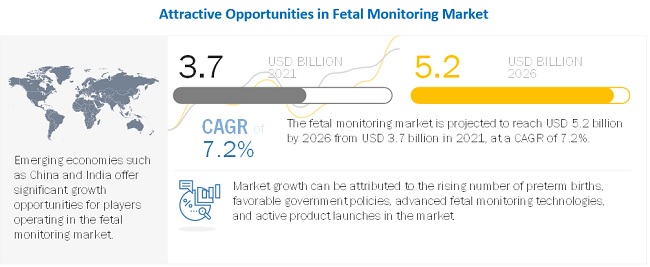views

COVID -19 Impact on the Fetal Monitoring Market
The coronavirus pandemic has compelled regulatory bodies, such as the FDA, to ease their regulatory norms for fetal monitors to support the uninterrupted care regime of expectant mothers. Relaxations in rules have paved the way for several key players to smoothly launch fetal monitors equipped with tele-ultrasound monitoring, noninvasive features, and portable technologies. For instance, the FDA released its updated April 2020 FDA guidance amid the pandemic, under which Philips successfully launched its fetal monitor, Avalon CL, in the US on June 12, 2020. The FDA’s enforcement policy for noninvasive fetal and maternal monitoring devices aims to increase access to devices that could reduce the need for in-clinic visits and reduce the burden on doctor’s offices and hospitals during the pandemic.
The outbreak of COVID-19 has led to various valuable partnerships among companies, which is anticipated to fuel the market's growth. For instance, in January 2021, Israel-based Nuvo Group (offering a remote pregnancy monitoring platform) entered into a commercial agreement with Axia Women’s Health, an innovative women’s health network. Under the agreement, Axia Women’s Health will be able to prescribe INVU to expectant mothers, which is expected to reduce the risk of exposure during COVID-19.
The fetal monitoring market is expanding with the latest innovative technologies, backed by escalating research and product launches. Fetal monitoring technologies are now being streamlined to provide greater assistance in utero fetal surgeries, consisting of challenging physical fetal access and technological complications. Fetal cardiac assessments have also witnessed progress that supports high-fidelity hemodynamic and continuous physiologic monitoring, thus enabling early diagnosis and treatment.
Computer-Aided Decision Support Systems and Artificial Intelligence (AI) are also utilized in continuous cardiotocography (CTG) or fetal heart rate (FHR) auscultation during labor. The patient’s electronic health records (EHRs) are utilized along with computational methods, machine learning, and deep learning tools.
Research and technological advancements in fetal monitoring systems have increased focus on noninvasive monitoring procedures. Obstetrics has been introduced with noninvasive diagnosis technologies such as Doppler studies, cell-free fetal DNA assessment, electronic fetal monitoring (EFM), and fetal acid-base status.
For More Info, Download PDF Brochure @ https://www.marketsandmarkets.com/pdfdownloadNew.asp?id=35700261
Fetal and neonatal assessments are carried out during antepartum via percutaneous umbilical cord blood sampling and during intrapartum with fetal scalp blood sampling immediately after birth. Fetal phonocardiography has been integrated with advanced data acquisition systems and databases. Progressing data analytics, synthetic data generation by advanced mathematical models, and classifications & processing algorithms are under active research & development to increase fetal motoring data processing efficacy.
Based on application, the market is segmented into antepartum and intrapartum. The antepartum segment accounts for the largest share of the market. Antepartum fetal monitoring is carried out throughout the gestation period to diagnose any congenital fetal abnormalities. The extensive monitoring regimes, recent product launches, surging prevalence of fetal anomalies, and maternal mortalities drive the growth of the antepartum segment.

[228 Pages Report] The fetal monitoring market is projected to reach USD 5.2 billion by 2026 from USD 3.7 billion in 2021, at a CAGR of 7.2% from 2021 to 2026. The development of noninvasive, portable, and advanced fetal monitors and emerging markets and strengthening infrastructure are expected to offer growth opportunities in the market during the forecast period.
The major players operating in fetal monitoring market are Cardinal Health, Inc. (US), Koninklijke Philips N.V. (Netherlands), GE Healthcare (US), Siemens Healthineers (Germany), FUJIFILM SonoSite, Inc. (US), Natus Medical Incorporated (US), Huntleigh Healthcare Limited (UK), The Cooper Companies Inc. (US), CONTEC Medical Systems Co., Ltd. (China), EDAN Diagnostics, Inc. (China), Neoventa Medical AB (Sweden), Bionet Co., Ltd. (South Korea), Progetti Srl (Italy), TRISMED Co., Ltd. (Republic of Korea), ShenZhen Luckcome Technology Inc. (China), MedGyn Products, Inc (US), Dixion (Germany), Promed Group Co., Ltd. (Hong Kong), Advanced Instrumentations (US), BRAEL-Medical Equipment (Poland), GPC Medical (India), BISTOS (Korea), Mediana (Korea), Life Plus (India), ChoiceMMed (China), Trivitron Healthcare (India), Dott Medical Co. Ltd. (China), Monarch Meditech (India), and Shenzhen Comen Medical Instruments Co., Ltd. (China).












